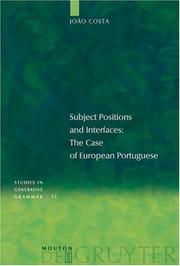| Listing 1 - 10 of 174 | << page >> |
Sort by
|
Book
Year: 2018 Publisher: Amsterdam ; Philadelphia : John Benjamins Publishing Company,
Abstract | Keywords | Export | Availability | Bookmark
 Loading...
Loading...Choose an application
- Reference Manager
- EndNote
- RefWorks (Direct export to RefWorks)

ISBN: 9789004455108 9789042000315 Year: 1997 Publisher: Edinburgh : BRILL,
Abstract | Keywords | Export | Availability | Bookmark
 Loading...
Loading...Choose an application
- Reference Manager
- EndNote
- RefWorks (Direct export to RefWorks)
This volume contains nineteen essays -- eighteen here presented for the first time -- exploring the question of subjectivity as seen from a linguistic perspective. Part I concerns the relationship between the linguistic subject, particularly the grammatical first person, and the subject in more general sense of 'person'. Topics covered include deixis, verbal marking and temporalisation, and performatives. Part II concerns the relationship of subjectivity to the experience of reading, and as such considers the semiotics of both literary and non-literary texts, inter-modal representation, authorship and intertextuality. The essays in the volume are principally influenced by the thinking of Saussure, Jakobson, Guillaume, Benveniste, Wittgenstein, Barthes and Deleuze, and the book will appeal to scholars with an interest in theoretical linguistics, semiotics, discourse, analysis and philosophy of language. Karl Simms provides comprehensive introductions to each of the parts, making the book accessible to inform general readers with an interest in cultural and communication studies.
Book
ISBN: 2801113239 9782801113233 Year: 2004 Volume: 47 Publisher: Bruxelles: Duculot,
Abstract | Keywords | Export | Availability | Bookmark
 Loading...
Loading...Choose an application
- Reference Manager
- EndNote
- RefWorks (Direct export to RefWorks)
French language --- Adverb. --- Topic and comment. --- French language - Adverb. --- French language - Topic and comment.

ISBN: 1282193929 9786612193927 3110197391 9783110197396 3110181126 9783110181128 9781282193925 Year: 2004 Publisher: Berlin New York Mouton de Gruyter
Abstract | Keywords | Export | Availability | Bookmark
 Loading...
Loading...Choose an application
- Reference Manager
- EndNote
- RefWorks (Direct export to RefWorks)
European Portuguese, like other Romance languages, display a great amount of word order variation. Out of the six logically possible permutations between Subject, Verb and Complement in a transitive sentence, five are possible: SVO, VSO, VOS, OVS and OSV. The primary goal of this book is to provide an analysis of the several positions where the subject may surface in European Portuguese. Departing from an architecture of the clause as sketched in early minimalist work, containing two subject-related functional categories above VP (AgrP and TP), it is shown that the subject may surface in all potential landing sites: Spec, AgrP, Spec, TP and Spec, VP. Moreover, just like any other argument of the clause, it is claimed that subjects also have the possibility of surfacing in a left-dislocated position, arguably adjoining to the clause's left periphery. It is shown that there is no free variation. Each of these positions may be occupied by the subject, only if two requirements are met:i) The position is made available by syntax; ii) The position does not violate any interface condition. In other words, the following model is argued for: syntax generates legitimate outputs. At the interface levels, each output may be selected or filtered out, according to requirements of the interface. The picture emerging from the proposal made in this book is the following: syntax proper does not need to refer to conditions best placed at the interface. All that is needed from syntax is that it generates an array of well-formed outputs. Such outputs may be evaluated a posteriori by each of the interfaces. If they meet requirements of the interface, they are selected as legitimate. If, on the contrary, some interface condition is violated, they are ruled out. Under this approach, three in-dependent results are derived: i) an explanation is found for the patterns of word order variation; ii) syntax proper may be reduced to its own tools, not having to manipulate semantic, discourse or prosodic variables; iii) the intuition that European Portuguese is an SVO language is derived: this word order corresponds to the one in which the subject occupies the only specifier position in which the other interfaces play no role.
Portuguese language --- Romance languages --- Topic and comment. --- Word order. --- Topic and comment --- Word order

ISBN: 9042909129 2877235203 9789042909120 Year: 2000 Volume: 1 Publisher: Louvain: Peeters,
Abstract | Keywords | Export | Availability | Bookmark
 Loading...
Loading...Choose an application
- Reference Manager
- EndNote
- RefWorks (Direct export to RefWorks)
Afrikaanse talen --- Langues africaines --- African languages --- Focus (Linguistics) --- Topic and comment. --- Topic and comment --- Discourse analysis --- Grammar, Comparative and general --- African languages - Topic and comment.
Book
ISBN: 9514108930 9789514108938 Year: 2001 Volume: 316 316 Publisher: Helsinki : Academia scientiarum Fennica,
Abstract | Keywords | Export | Availability | Bookmark
 Loading...
Loading...Choose an application
- Reference Manager
- EndNote
- RefWorks (Direct export to RefWorks)
Portuguese language --- Syntax. --- Topic and comment. --- Emphasis. --- Emfase (taalkunde) --- Portugees. --- Romance languages --- Emphasis --- Syntax --- Topic and comment --- Portuguese language - Syntax. --- Portuguese language - Topic and comment. --- Portuguese language - Emphasis.

ISBN: 3878082878 9783878082873 Year: 1986 Volume: 287 Publisher: Tübingen: Narr,
Abstract | Keywords | Export | Availability | Bookmark
 Loading...
Loading...Choose an application
- Reference Manager
- EndNote
- RefWorks (Direct export to RefWorks)
Italian language --- Grammar --- Topic and comment --- Word order --- -Italian language --- -Romance languages --- Topic and comment. --- Word order. --- -Topic and comment --- Romance languages --- Italian language - Topic and comment --- Italian language - Word order
Book
ISBN: 9027229503 Year: 2001 Volume: 46 Publisher: Amsterdam : Benjamins,
Abstract | Keywords | Export | Availability | Bookmark
 Loading...
Loading...Choose an application
- Reference Manager
- EndNote
- RefWorks (Direct export to RefWorks)
Grammar [Comparative and general ] --- Topic and comment --- Syntax
Book
ISBN: 9780199740369 9780199740376 Year: 2010 Publisher: Oxford Oxford university press
Abstract | Keywords | Export | Availability | Bookmark
 Loading...
Loading...Choose an application
- Reference Manager
- EndNote
- RefWorks (Direct export to RefWorks)
Grammar, Comparative and general --- Complement. --- Syntax. --- Topic and comment.
Book
ISBN: 9789027264244 9789027200525 9027264244 9027200521 Year: 2018 Publisher: Amsterdam Philadelphia
Abstract | Keywords | Export | Availability | Bookmark
 Loading...
Loading...Choose an application
- Reference Manager
- EndNote
- RefWorks (Direct export to RefWorks)
This volume explores typological variation within nonverbal predication in Amazonian languages. Using abundant data, generally from original and extensive fieldwork on under-described languages, it presents a far more detailed picture of nonverbal predication constructions than previously published grammatical descriptions. On the one hand, it addresses the fact that current typologies of nonverbal predication are less developed than those of verbal predication; on the other, it provides a wealth of new data and analyses of Amazonian languages, which are still poorly represented in existing typologies. Several contributions offer historical insights, either reconstructing the sources of innovative nonverbal predicate constructions, or describing diachronic pathways by which constructions used for nonverbal predication spread to other functions in the grammar. The introduction provides a modern typological overview, and also proposes a new diachronic typology to explain how distinct types of nonverbal predication arise.
Amazon River Region --- Amazonia --- Languages --- Topic and comment
| Listing 1 - 10 of 174 | << page >> |
Sort by
|

 Search
Search Feedback
Feedback About UniCat
About UniCat  Help
Help News
News